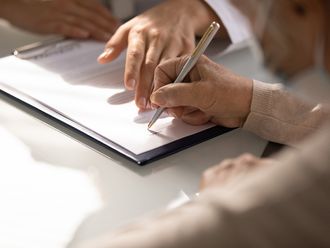
Dubai: The spine consists of multiple bones called vertebrae that are stacked on top of each other. In between each vertebra there are protective circular pads called discs that contain a softer gel-like substance. A slipped disc occurs when one of the discs is damaged and presses on the nerves.
There are a number of factors that can put increased pressure and strain on the spine such as bending awkwardly, jobs that involve heavy or awkward lifting, lots of sitting, particularly driving, being overweight or obese, weight bearing sports, such as weightlifting or traumatic injury to the back. Smoking also plays a role as it causes the discs to lose their natural flexibility. As we get older, our spinal discs start to lose their water content, making them less flexible and more likely to rupture. The damaged disc can put pressure on the whole spinal cord or on a single nerve.
Magnetic resonance imaging (MRI) scans are effective at diagnosing the position and size of a slipped disc. They can also pinpoint the affected nerves. A CT scan can also pinpoint a slipped disc, although it is often not as effective. X-rays are not generally used as a test to look for slipped discs as they only show the bones and do not give a view of the nerves and spinal cord.
Treatment of a slipped disc usually involves a combination of physiotherapy and medication. Corticosteroid injections can also be given to the lower spine to help reduce pain and inflammation.
Surgery to release the compressed nerve and remove part of the slipped disc may be considered in severe cases, or if the pain continues for longer than six weeks and there is progressive weakness in the muscles. The aim of surgery is to cut away the piece of the disc that bulges out. This is known as a discectomy and it can be done in several ways e.g., microdiscectomy, endoscopic discectomy or artificial disc replacement. Post surgery, the patient may need to rest completely for the first couple of days to speed up the recovery and ensure exercise that is gentle and does not put a strain on the back. Swimming is an ideal form of exercise because the water supports the weight and puts very little strain on other joints. “To avoid back pain and help prevent a slipped disc, one should keep mobile, exercise regularly, maintain good posture while sitting and standing, use safe techniques when lifting heavy objects, avoid sitting for a prolonged period of time and quit smoking The writer is specialist orthopedic Surgeon at Medeor 24x7 Hospital, Al Ain











